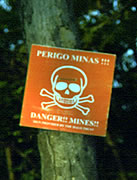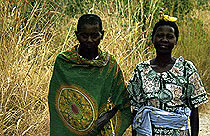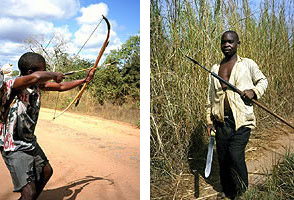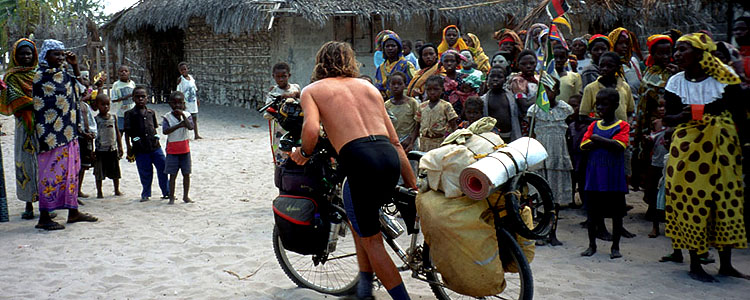While I was getting further into the Niassa province, I started to discover the true dangers. I remember that in the city some people told me: “On that road you will suffer”.
Northern Mozambique
When I arrived to Mozambique I met Luis. And Luis, as soon as he knew that I came from South Africa, told me: “Here is where real Africa begins“.

I remember that many South Africans had warned me about the northern part of this country, because of the lack of roads and bridges and mostly because of its people, who live in the most precarious conditions.
After traveling at the lake of Malawi and part of its culture, I returned again to Mozambique navigating on a sailboat. I disembarked at Cobue, in a huge pasture that existed on the sand, thus making it hard to arrive with the bicycle.
The information from Malawi regarding that little village was scarce. Upon my arrival I discovered that its people remain isolated with the rest of the country due to the conditions of the roads arriving to the place. Those roads have not had any maintenance work since 1975 -the year of independence- so that the people of the area can only supply themselves through the waterways via Malawi. Matías, who traveled with me on the boat, told me that so far this year (6 months) only one truck from Zimbawe had arrived at the village.
I knew then that my crossing through the province of Niassa would be a real odyssey.
Niassa, the forgotten province – Km 18,520
Three days I was at Cobue trying to decipher which would be the best road to Lichinga, the capital of the province.
I listened to many opinions and walked a few kilometers on foot to check the condition of the road leaving the village. Finally, being already Sunday, I left Cobue on a small path or “cortamato“, “cutting in the jungle“, as locals use to refer to it.

During quite some portion of the path two natives joined me, helping me to cross a huge mountain where there still existed land mined areas. They guided me and helped me also with my bicycle, because the road was impossible to travel on due to the rocks and dense vegetation. They finally showed me the path that would lead me to the next village.
There I looked up the Reglo (Chief), who offered me a papaya and designated Vladimir to be my guide, lending him his own bicycle. Almost immediately I realized that I could have never found the right direction alone: there were an infinite number of paths. After 20 kilometers through mountains and narrow rocky roads, I said goodbye to Vladimir on the afternoon.
The disadvantage of being white – Km 18,720
It took me three days to travel the 200 kilometers to Lichinga. The second night I slept in Micucue, a small village that, as many others, doesn´t exist on the maps.

Their chief offered me to stay in a modest mud house he owned and where nobody lived. There I left my things and a few meters away, beside the Reglo, I started to cook some rice.
At some time I had to return to my bike because I had forgotten the lantern. Everything was dark. I moved around feeling the shapes. After a few minutes I found the lantern and turned it on. I noted that the back door was semi- opened and then, a little frightened, I pointed the light to the back of the house. By the chickens, behind the only wall, I could see the foot of someone hiding.
Without understanding too much, I took a deep breath and asked: “What are you doing?“. At that moment, a boy of about 20 years came out of the area where the bed was and started to invent things. I quickly checked my belongings and the boy, who seemed more afraid than me, ran out of the back door.
Despite the fact that in Mozambique I have felt safer than anyplace else in Africa that I visited, to be white is equal to having money.
When I arrived to Lichinga I had to change currency but I was confronted with a burocratic hurdle at the Bank. On that street a very good offer seduced me and I changed 100 dollars. I had to be very alert not to get false currency, but the old trick of folding and counting twice the banknotes surprised me. I lost the equivalent of 30 dollars, but I learned a good lesson.
Enigma in Lichinga, the capital

Lichinga is a city of 36.000 inhabitants. The main roads are asphalted but there are no high buildings. In spite of having electricity, the roads in the city are not lightened.
It was hard to choose the best way to the coast of the Indic Ocean, from where I would continue to Tanzania. People of the city told me that the longer road (1.100 kilometers) was the safest and that the other one, even though being more direct, was in terrible conditions with extensive areas that were uninhabited.
But I also talked to people who came from the places I was heading to, and even though they didn’t know the entire shorter road, they assured me, not without some cynicism, that on a bicycle it wouldn’t be difficult to travel its 700 kilometers.
Finally, and still with some doubts, I opted for the shorter alternative. Maybe, unconsciously, I sensed that this way I would find a true experience of what Africa is.
One only food
The province of Niassa is the biggest of the country, but also the less populated. In the interior most villages have no electricity, and have water only from the rivers. Houses are made of mud and straw and the people cultivating only one thing: corn.

After the rain months, that end with the summer, the time for recollecting comes. The fields are large and the natives harvest lots of cobs, often as many as to feed their families for a whole year. To preserve them, they put them in a “cereiro“, a giant straw basket built on branches at about 1 meter from the ground, where it´s possible to keep some thousands of corncobs.
Only the larger villages were aided by the government in means of donations of grinding machines. With them, people are able to produce cornmeal, which is used for cooking their principal food: the shima.
A dangerous zone
While I was entering more the province I started to discover true dangers, unknown to me.
I got to know some South African missioners that had lived there for some years. Through them I knew of many cases in which leopards or lions had killed persons.
In the province’s center there is a very wild area, maybe one of the wildest in the entire continent: the “Niassa Reserve“.
Even though all the animal flow is not yet concentrated in it, many persons are working on it to create the possibility, in the future, to allow the area to be in a tourist way exploited. Some of these animals are found drifting in the surroundings and that is why many people live with huge enclosures.

On my way I heard many stories, like the one of the elephant who destroyed the vegetable garden of a farmer or the other of a man who went to gather wood one afternoon and three days later, his body was found ripped up by a beast.
Crossing this province on my bicycle, it was inevitable for me to reflect for the first time on my mental health. Strange experiences kept happening: a few times I came across people carrying huge spears or an arch and arrows to hunt some animals.
I also came across those who put the pastures on fire to clear the almost inexistent roads, which turned out to be another danger for me.
Neither cars nor trucks usually travel this road: many bridges where destroyed during the war and even though more than 10 years have passed; they still have not been rebuilt. I hardly came across another bicycle. The fact is, that the distances between the villages sometimes reach 80 to 100 kilometers.
I remember when in the city someone told me: “On that road you will suffer“. During two days I pedaled with my body covered with clothes because of the “Tsetse flies“, as the locals call them. These unbearable flies joined me on my trip for 150 kilometers, sometimes riding on my bike and driving me to despair. But luckily they turned out to be quite slow: I must have killed a hundred.
Strange civilization – Km 19,115
After four hard days heading to the coast I arrived to the middle part of the way: Marrupa. A big village where I decided to rest a little and where I found a place to stay… which even had a restaurant! I still remember it: “Pension- Restaurant: Bela Vista“.

Upon my arrival I met Cornelio: I approached him to ask where the pension was and he didn’t leave me for the rest of my stay.
It happened often in this country that, when I arrived at a village, even it being so far away, I ended up being joined, sometimes not being of my preference or choice.
Cornelio walked with pride next to me and showed himself to his acquaintances. Later he explained that for them, walking with a white person is an honor.
Campaign against AIDS
During my trip through Africa I have already seen dozens of organizations and ONG´s trying to help about different problems of the people. Their work is mainly based on nourishment programs, education and health.
Today AIDS is the most important problem. In Marrupa I learned about the difficulties in making the people aware of the HIV virus. The degree of ignorance of the population was striking to me.
It was sad to listen to those that believed that AIDS caused dhyarrea and headache, and believed that it was first contracted by the women rather than by men. Some professionals working on the awareness programs told me that in the interior people don´t trust condoms and believe that the real germ of the illness lies in it.

Some days afterwards I got the proof that the condom is just a toy for the younger ones.
Arriving to the coast – Km 19,426
When I arrived to Metoro, the small village located just 80 kilometers from the sea, I found that the place, even though it had no electricity, had a video room working with its own electricity producing motor.
More than 150 people were paying their entrance. They were of different ages: from children to young people of about 20 to 25 years.

Everybody was concentrated on an Asian martial arts film. The funny -or sad- thing was that nobody understood anything, because in the interior of this country, a Portuguese colony with over ten dialects, films are released in English.
The next day I arrived at Pemba and dedicated some days to my bicycle, which every time is demanding more and more attention. My back luggage carrier was broken, luckily though, in a huge shipyard, I found a person who welded aluminum.
After that I parted for the islands of Ibo and Matemo where I found the Makua women, who according to their traditions, still paint their faces. Finally I went to Pangane beach, maybe one of the most beautiful beaches I got to know on my trip so far.

There I rested and swore that I´d always analyze carefully the advices of the people of the interior, because what may be normal to them, for me might turn out in a hard odyssey.


